LIQUID AIR—ITS WONDERFUL POWER
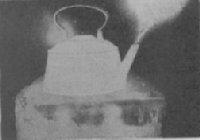 | | Liquid air boiling on a block of ice. |
To Charles E. Tripler, a scientist of New York City, belongs the credit for having made liquid air familiar to the scientific world, cheapened its production, and applied it to practical commercial purposes.
It seems almost a contradiction in terms at first thought, and yet scientists have been able to liquefy not only air but many other gases, while they can also turn solids into liquid, and the resulting liquid into gases. It is all a matter of temperature and pressure.
Tripler, however, was not the pioneer in experiments. Scientists had long observed that to compress a gas into a reduced volume, raised its temperature greatly. The heat thus resulting was to be generated by the pressure applied, but experiments soon proved it was not caused by the actual inerease of the heat of the whole body, but rather by the concentration of the heat of the entire mass into the smaller space.
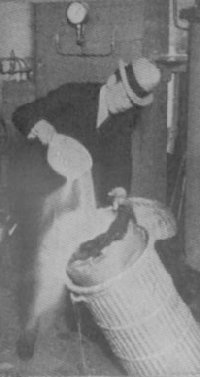 | | Packing liquid air for shipment. |
Later experiments showed that if this gas under pressure was cooled, and then allowed to expand to its former volume, it would fall greatly in temperature, and in practice a drop of 200 degrees was obtained. In 1877, the first real headway was made by scientists in their efforts to liquefy air. The first real success in these experiments was made by Raoul Pictet, who submitted oxygen gas to a great pressure, combined with intense cold, and produced a few drops of the clear liquid that soon evaporated into the air after a few moments of violent bubbling. In 1892, there was a like success with nitrogen, the other constituent of air. About the same-time Prof. Dewar, of England, performed the, same experiments, and then succeeded in producing a small quantity of liquid air, or rather a sort of slush of air, water and ice. His
experiments aroused the utmost interest among scientists, but the cost of the apparatus and processes, which amounted to $3,000 for this first ounce of liquid air, limited it to laboratory experimentation.
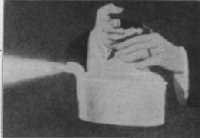 | Liquid air boiling by heat of the
atmosphere. |
It was Prof. Tripler who discovered the means by which this wonderful product could be made with ease, at a cost of not more than 20 cents a gallon. Tripler's process comes as near being a practical form of the chimerical perpetual motion as can be conceived, as he utilized power generated by the liquid air itself to produce more liquid air, and as the production from a given quantity is in each instance a larger quantity, there is a constant increase of the power at command.
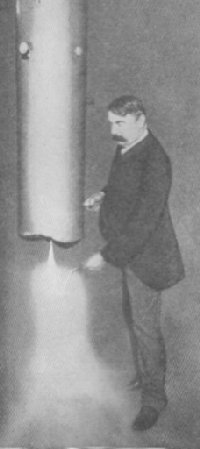 | | Drawing liquid air from the liquefier. |
The apparatus for the manufacture of liquid air, in addition to the power plant, is an air compressor, and a barrel-shaped tank about 15 feet high, penetrated by a multitude of small pipes and valves, protected by felt and canvas to keep out the heat. This contrivance is so arranged that the expanding air, which constantly grows cooler, passes about the pipes containing the working material. Air is placed under a pressure of 2,500 pounds to the square inch, and cooled to about 50 degrees by being passed in pipes through running water. From there it is conveyed to the receiver through two different sets of pipe, one containing the air to be liquefied, and the other the air that does the work of liquefying, both under the same heavy pressure. By opening a tap in the receiver, the air from the latter pipe rushes up and around all the pipes in the barrel-like space, expanding, reducing the pressure, taking up the heat wherever any can be found, growing warmer, and gradually rising to the top of the space.
While this process is in operation the air in the pipes has been gradually returning to the compresser, where it is again brought under pressure and cooled, only to be released once more in the receiver, there to absorb more heat from the confined air in the pipes. So rapid is this process that the temperature of the air goes down 100 degrees every time it is thus chilled, and it takes only fifteen minutes to produce the desired result. At the expiration of the fifteen minutes the faucet at the bottom may be opened, and the liquid air, at a temperature of 312 degrees below zero, begins to flow from the pipes.
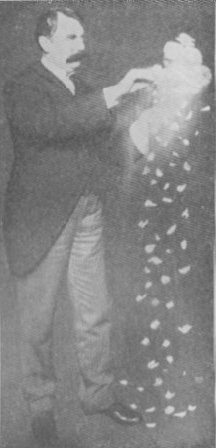 | Roses frozen with liquid air
rendered brittle as glass. |
Liquid air is of such an expanding nature that if confined it would explode. In order to preserve the product thus yielded various devices have been prepared. One of the vessels used for carrying liquid air is a bulb of glass, which is surrounded by an outer vessel, of the same material, the two having a vacuum between them and Joined by a common neck at the top. The vacuum thus produced delays the passage of heat, so that the evaporation of the liquid in the inner tube is reduced to a minimum. In a shipment of nine hours air packed in the above manner, loses less than one-third of its bulk.
Liquid air is eleven and one-half times as powerful as compressed air, and yet it may be carried in a pasteboard box, while the heaviest steel tanks would be required to control as much energy in compressed air. In the meantime Prof. Tripler goes on experimenting with this wonderful air. Inventors of airships are seeking something that combines great power with lightness; submarine navigators want an economical motive power and air for the crews to breathe; deep-sea divers hope that some service may be rendered to their perilous profession by the use of casks of the liquid suited to their apparatus, and automobiles have been adapted to this power. By the use of liquid air, a rose may be frozen in its full form, or an egg may be made so solid that when broken, it will scatter like a powder. The surface of a frozen potato is as hard as stone and beautiful as ivory. Frozen butter may be pounded in a mortar until it is as fine as flour, and raw beefsteak will become pale and then break, like petrifled wood. Mercury is frozen, and alcohol is made stringy and white by this air, and steel bars, when dipped into this liquid, may be burned as readily, as a piece of dry wood.
ITS POSSIBLE USE FOR FUEL AND PROPULSION.
In the not distant future, liquid air may supplant some forms of fuel, for when mixed with any form of carbon, it burns rapidly or explodes. Thus it may be used in interior combustion engines, for instance, the gas engine.
FULL RECOGNITION OF A GREAT DISCOVERY.
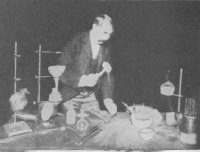 | Driving a nail with a hammer made of
mercury frozen by liquid air. |
When, with its lightness and extreme potency, it shall be utilized in helping to solve the problem of practical aeronautics, and shall also be made to serve, with a suitable motor, in propelling submarine craft, while at the same time supplying breathing air to the crew, through compression in storage tanks, then, indeed, will be fully recognized the great significance of the discovery of liquid air.
NEW PROCESS OF MAKING STAINED-GLASS WINDOWS
BREAD SUPPLIED FROM THE ATMOSPHERE
Table of Contents
Return to Main Page
© 1998, 2002 by Lynn Waterman
|





